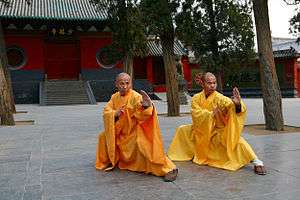Nanquan
Nanquan (Chinese: 南拳; pinyin: Nán quán; lit.: 'southern fist', or Chinese: 南派; pinyin: Nán pài; lit.: 'southern school') refers to a classification of Chinese martial arts that originated south of the Yangtze River of China with emphasis on "short hitting" and the arm movement, predominantly in southern styles such as Hung Kuen, Choi Lei Fut, Hak Fu Mun, Wuzuquan, Wing Chun, and so on.[2]
| Also known as | Southern Fist |
|---|---|
| Focus | Striking, weapons training |
| Country of origin | China |
| Famous practitioners | Yu Dayou[1] Qi Jiguang (a Northern Shaolin Kung Fu practitioner who contributed to the development of the southern styles)[1] |
| Parenthood | Shaolin Kung Fu |
| Descendant arts | Choy Li Fut, Choy Gar, Hung Ga, Lau Gar, Li Gar, Mok Gar, Wing Chun |
| Olympic sport | Wushu (sport) |
| Part of a series on |
| Chinese martial arts (Wushu) |
|---|
 |
| Wushu in the world |
|
Historical locations
|
| Wushu athletes/practitioners |
|
Legendary figures
|
|
Historical individuals
|
|
Modern celebrities
|
| Wushu influence |
Contemporary Wushu Nanquan
The contemporary Wushu event Nanquan is a modern style created in 1960[3] derived from martial arts derived in the Chinese provinces south of the Yangtze River and predominantly those styles popular in Guangdong, Guangxi, Fujian and Zhejiang.[1] The basis of contemporary Nánquán hail primarily from traditional Cantonese family styles of 洪 (Hung), 李 (Lei), 劉 (Lau), 莫 (Mok) and 蔡 (Choi) along with their more contemporary Kung Fu variants of Choi Lei Fut, Hung Ga and Wing Chun.[3]
Contemporary Nanquan features vigorous, athletic movements with very stable, low stances, extensive hand techniques and a vocal articulation called fasheng ("release shout") which is the predecessor of the Japanese and Korean martial arts kiai. Power is driven from sharp waist movement with special emphasis on fast stance transition to generate power and speed in the arms. Signature hand techniques of Nanquan are the consecutive downward strikes of the left and right fist called Gua Gai Quan (Gwa Kup Kuen; 挂盖拳),[4] and consecutive upper cut while driving forward called Paoquan (Pow Kuen; 抛拳). There are relatively few kicks in Nanquan although the Tengkong Pantui Cepu (腾空盘腿度侧扑; "flying cross legs kick and land on the side") and Li Yu Da Ting (鲤鱼打挺直立; carp skip-up) are very common in advanced Nanquan routines. Nanquan also has its own contemporary weapons - the Southern Broadsword (Nandao; 南刀) and Southern Staff (Nangun; 南棍),[5] which were included in the International Wushu competition in 1999.
In 2003, the International Wushu Federation (IWUF) changed the rules of contemporary Nanquan to make jumping techniques (难度) mandatory in Nanquan routines. Jump kicks spinning in mid-air between 360 and 720 degrees before touching the ground are now used in all Nanquan forms along with Stationary Back Flip (原地后空翻) and Single Step Back Tuck (单跳后空翻) for advanced competitors.
See also
- Cai li fo
- Hung Kuen
- Northern and southern China
- Wing Chun
- Wushu (sport)
References
- Guangxi Wang (2012). Chinese Kung Fu. Cambridge University Press. ISBN 05-2118-664-1.
- Thomas A. Green & Joseph R. Svinth (2010). Martial Arts of the World: An Encyclopedia of History and Innovation. ABC-CLIO. ISBN 15-9884-244-7. Two volumes.
- Sensei/Renshi Nathan Chlumsky (2015). Inside Kungfu: Chinese Martial Arts Encyclopedia. Lulu.com. ISBN 13-2911-942-8.
- "Wushu Nanquan Application - Guagaiquan". UMBC Wushu. 5 March 2015. Retrieved 2016-10-09.
- DK (2013). The Sports Book. Dorling Kindersley Ltd. ISBN 14-0935-033-9.